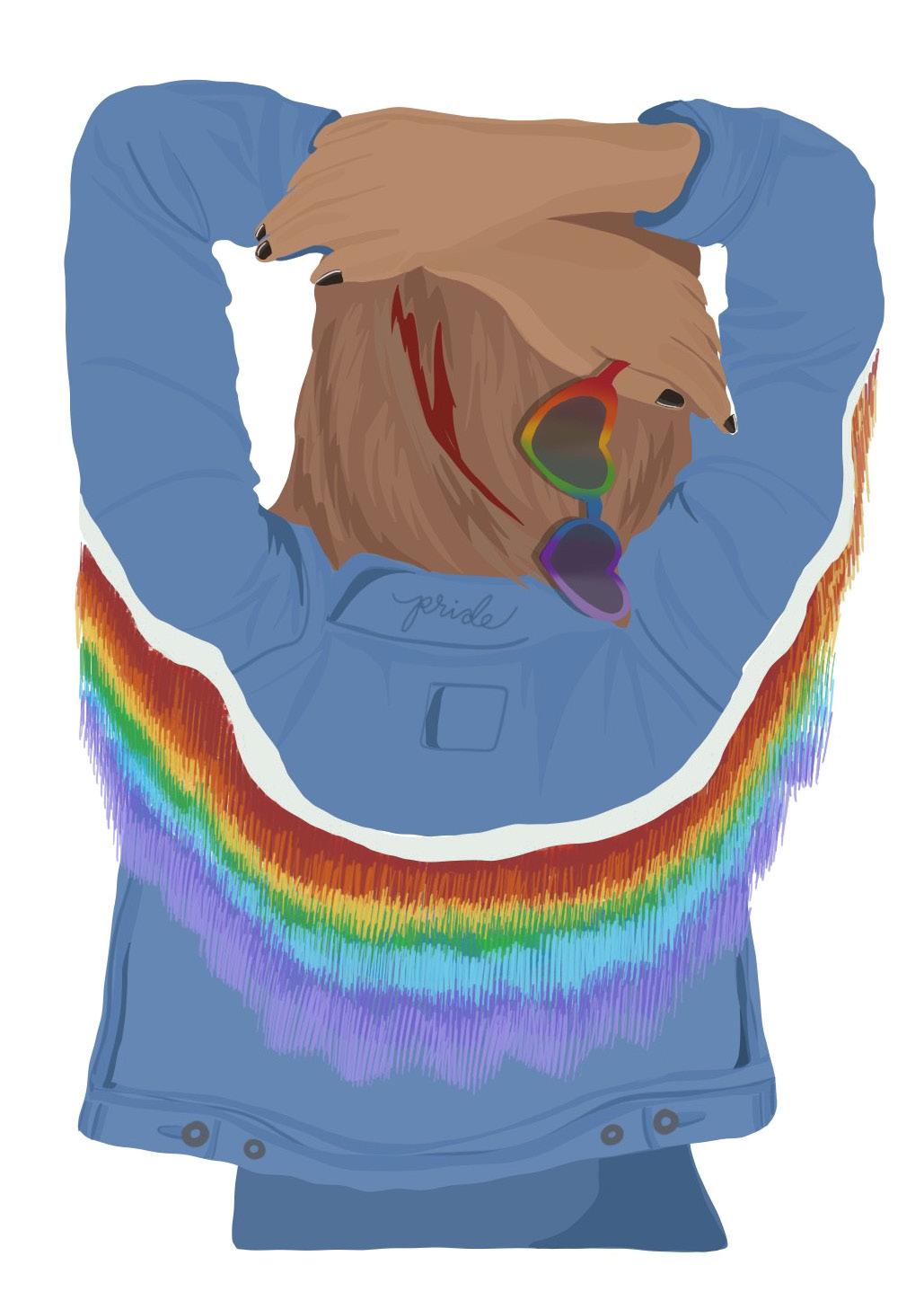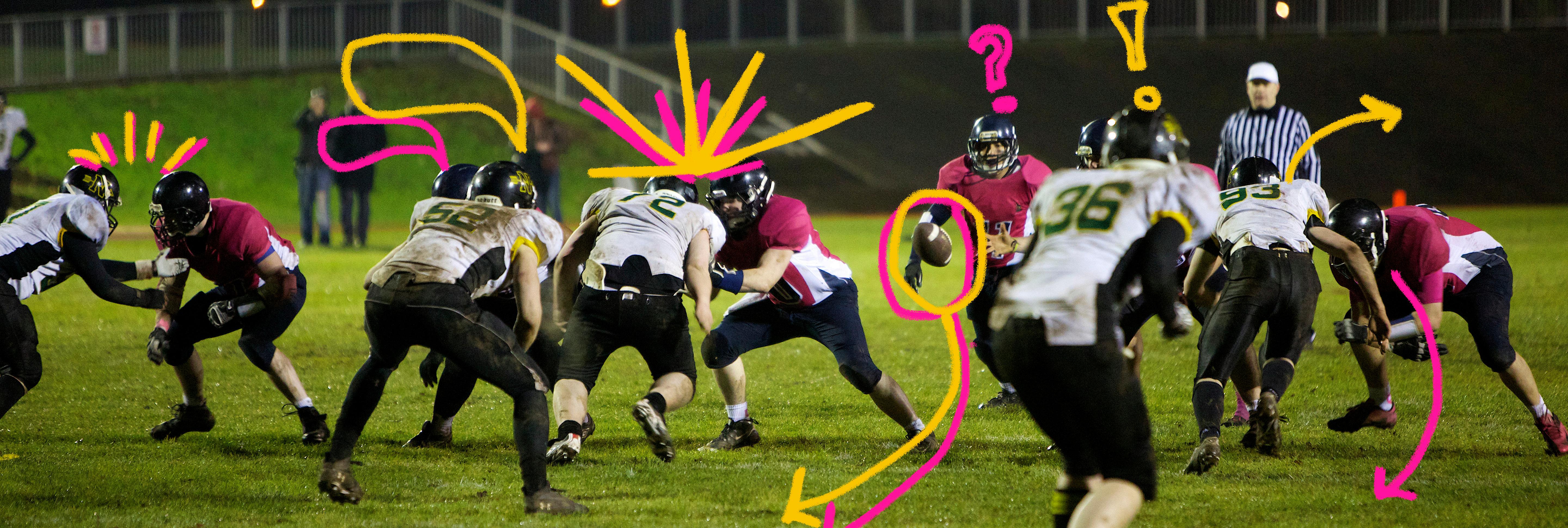
41 minute read
Unapologetically You
from Issue 266 - Us
IMPACT Unapologetically You: Freedom of Expression in the LGBT+ Community
Gen Z appears to have had more freedom to express themselves than any other generation; Manjula discusses how this has been shown by the LGBT+ community.
The ability to express oneself through art is one of the most liberating things, and our generation is lucky in that now our freedom of expression is so vast and great. We, as a society, are finally starting to move forward towards the inclusivity of all people, no matter their race, gender, sexuality, class, ability and age, but for gender and sexuality especially, expression through art has been amazing.
‘The increase of androgenous fashion within popular culture, influenced by the gender fluid identities in the LGBTQ+ community, has led to new and original styles’
In the 21st century, the LGBTQ+ community has become more accepted than ever before, and the ways in which different aspects of this community have led to artistic expression is incredible. The increase of androgenous fashion within popular culture, influenced by the gender fluid identities in the LGBTQ+ community, has led to new and original styles. Unisex clothing has become more common, and it allows people who don’t adhere to the gendered clothing norms to express themselves through their fashion in order to show and be who they truly are.
Another way in which the LGBTQ+ community have been able to express themselves through fashion is through pride flags and colours which enable people to be proud of who they are. Yearly Pride events have become a tradition and it is inspiring to see the artistic expression of the community through things like makeup, clothing and hair colours. The existence of Pride has fed into other art forms such as paintings, sculptures and film which just goes to show how loud expression from the LGBTQ+ community is. Gilbert Baker was the artist that actually designed the rainbow flag and his art along with many others expresses the identities within this community. For example Zanele Muholi, who uses their experience as a black queer person to create films, and Francis Cannon who does illustrations focusing on the body, gender and sexuality.

‘The makeup, fashion and performances that drag queens do is not only a way in which they can express themselves but is also for entertainment purposes’
Lastly, the most well-known form of artistic expression from the LGBTQ+ community is drag, and the television show RuPaul’s Drag Race has encouraged it to become popular. The art form of drag is predominantly carried out by gay men, and despite its many misconceptions, more and more people are learning about it and appreciating the talent and creativity that goes into it. The makeup, fashion and performances that drag queens do is not only a way in which they can express themselves, but is also for entertainment purposes, hence the popularity of RuPaul’s Drag Race.

The LGBTQ+ community have expressed themselves through so many different art forms, from film to makeup. As we continue to move forward in society, we can appreciate and be inspired by the way in which the community uses their freedom of expression.
By Manjula Simon
Illustrations by Harriet Bray Page Design by Sarah MacAllan
The Artistic and Cultural Legacy of Video Games
By Daria Paterek Illustration and Page Design by Chiara Crompton
Daria weighs up the artistic strengths of the medium, and how games tackle serious subject matter.
Video games synthesise many traditional artforms: illustration, narrative, music, and animation to create a revolutionary fusion. If treated respectfully, video games have massive potential to be considered art.

Video games’ artistic potential comes from their ability to do what no other medium can; fully immerse their audience into a fictional world. Games are increasingly using that immersion to tackle real-world issues, becoming a platform to educate and raise awareness in an intimate, personal way.
Video games can be used to destigmatize and start conversations about mental health. Celeste, a 2D platformer, tackles the issue of depression and anxiety. The game’s complex levels are physical manifestations of the protagonist’s mental health. Celeste spreads awareness about the reality of mental illness: low self-esteem, self-deprecation, and catharsis.
‘Video games not only tackle issues on a micro, personal level but also on a macro, societal one.’
Video games not only tackle issues on a micro, personal level but also on a macro, societal one.
Games like Papers Please and This War of Mine explore human displacement, war, and migration through the perspectives of a border official working for a fascist regime, and a group of civilians struggling to survive a warzone. These games demonstrate the unique strengths of the medium because they are user-driven. The player is forced to make moral decisions driven by their conscience that create in-game consequences. The player has free reign to be completely selfish at the expense of others or maintain a moral stance that could threaten their survival. The few times film has attempted giving audiences this kind of autonomy, like in Black Mirror: Bandersnatch, it came off as shallow and gimmicky.
Not all games that tackle heavy subjects do it well. Detroit Become Human draws distasteful parallels to the civil rights movement and Holocaust to tell its story of android liberation. Detroit uses segregation in buses and concentration camps for shock value, encouraging players to see historical parallels to make itself look ‘deep’. However, the execution is lazy and offensive. Detroit’s misappropriation of Black and Jewish history shows how not to tackle serious issues.
‘Even games with reputations for mindlessness, like Grand Theft Auto, invite audiences to question their society with their close replication and parody of reality.’
Even games with reputations for mindlessness, like Grand Theft Auto, invite audiences to question their society with their close replication and parody of reality. Why are the characters in the positions they are? Do societal institutions facilitate crime? The protagonist of 2004’s GTA: San Andreas is CJ, a black man. CJ talks directly about how discrimination and systematic oppression funnelled him into a harsh life of crime and poverty. Though sometimes dated and politically incorrect, GTA’s provocative tackling of modern-day issues puts itself at the centre of the cultural zeitgeist.
If the most commercially successful games can provoke conversation about personal and societal issues, surely that proves they aren’t just empty entertainment, and should be considered art?
Growing up with Games
The raised eyebrows of older generations at the mention of video games are something many of us are familiar with. Although tiresome, is this disapproval understandable? The language around the hobby can be, admittedly, unflattering. We’re diagnosed as growing up with games, being corrupted and becoming addicted—interconnected with the virtual world from our very beginnings. It seems without our online presence our generation becomes lost.
‘[Games] can even according to a recent UCL study, reduce depressive symptoms’

Alice explores how video games continue to shape our generation.
Attachment to games could be a natural progression of entertainment; their immersive simulations let us escape and vent without danger. Our need for escapism has become more acute in the pandemic, but even before then games provided for many isolated individuals and can even, according to a recent UCL study, reduce depressive symptoms.
Despite this, older generations have long accused adrenalinepumping games of causing real-life violent behaviour: The American Psychological Association reviewed studies conducted from 2005 to 2013 and found some evidence video games contributed to ‘aggressive cognitions’. However, more recent studies published in the Royal Society Open Journal found only a ‘minuscule’ connection: in reality, there is no real danger—other than perhaps strained eyes.
Video games are being incorporated into traditional professional environments; they hone beneficial skills such as hand-eye coordination and problem-solving, with studies concluding that skills harnessed by playing video games can help careers such as being a surgeon or pilot. The US Air Force even wants to use gaming to find the next generation of pilots.
Video games themselves offer us many new career paths, whether you’re making or playing them: when we think of video games, it’s likely through the explosion of young entertainers that dominate online social platforms like YouTube and Twitch. You may have heard of Tyler ‘Ninja’ Blevins, the multimillionaire Fortnite streamer who topped Forbes list of top-earning gamers and signed deals with companies like Adidas. He even has his own sneaker.
‘The connotations of being a ‘girl gamer’ remain derogatory’
However, that same Forbes list showcases a key issue in the gaming industry. All top 10 earners are male. Studies done by the Entertainment Association of Canada show video games are played almost equally by males and females, and yet the connotations of being a ‘girl gamer’ remain derogatory. You may have heard of PewDiePie, but who knows Kayla ‘Squizzy’ Squires, first female professional Call of Duty player?
The truth is all generations have their idle habits. Although ours seem flashier, video games just remould what has come before. People have always enjoyed stories involving adventure and violence. Is modern gaming really such a revolution? Perhaps not. It’s effects on our generation have been, like many things, a mix of good and bad. Gaming should therefore remain a part of our lives, as long as this generation remembers – all good things should come in moderation.
By Alice Busvine Illustrations by Sophie Forrester Page Design by Sarah MacAllan
Interview: Drug Store Romeos on Soundtracks and Synaesthesia

With their transcendent, ethereal and dreamlike sound, Drug Store Romeos have gained a fanbase across the globe. Amrit Virdi chatted with the talented indie dream-pop trio to discuss creativity in lockdown, synaesthesia and their musical bond.
United by the power of technology in lockdown, Hampshire three-piece Drug Store Romeos haven’t let the current circumstances halt plans for their debut album, now fittingly revealed as The World Within Our Bedrooms. Vocalist Sarah explains “we basically had a year of having to work quite independently, and I think it went really well to be honest, as we then fused our pieces together,” when discussing the process behind their upcoming record.
Interestingly, colour and visuals drive the band’s otherworldly sound, as guitarist Charlie reveals “there is one of our songs, that is going to be a single, that probably only exists because of that exact colour of purple,” as he gestures towards a fluorescent purple light. Whilst the band were quick to state that their synaesthesia was not “as cool as a lot of people’s”, the detail Charlie describes about his “third eye” vision when it comes to the interrelation between colour and music is simply fascinating.
The band are joyously close-knit having been friends since their school days and a shared passion for music evidently plays into their illusive melodies. Sarah refers to the experimental and psychedelic tunes of British Band Broadcast as being their “mother hen to discovering ourselves”, as Charlie recalls Broadcast’s music as evoking imagery of “a kind of moderately isolated, young, English woman who is kind of melancholic”, which the band were aiming to recreate. Despite their differing musical backgrounds, ranging from jazz and classical to 90s alt-rock, the friendship holding the band together is rock solid and musically unites the trio, as drummer Jonny amicably referenced his bandmate as introducing him to new realms of music. “Finding friends like Charlie early on who had quite an established music taste was very useful for me because I could look at that and kind of get more of an understanding of my own perception on music”, the drummer explains with a grin.
Equally grin-inducing and described by Charlie as “very surreal” is the use of the band’s techno-track Frame of Reference in the Amazon Original film ‘The Map of Tiny Perfect Things’. Leading to a skyrocket of their streams in America, Charlie expresses his gratitude by saying it is “the biggest compliment”. The future is bright for Drug Store Romeos as they remain a tight-knit trio united by music. Frame of Reference is available to stream now, with their debut album The World Within Our Bedrooms out on June 25th.
By Amrit Virdi Page Design by Chiara Crompton
‘Image courtesy of Paul Hudson on Flickr’; https://unsplash.com/photos/ sBc8oen_ocg

Music for the Mind
In a world overtaken by chaos and uncertainty, many of us turn to music to calm the mind and momentarily escape reality. Christina delves into how our brains understand music, and Gemma Cockrell provides the personal touch with how one album helped her through lockdown.
Music arrives at the ear in the form of soundwaves which are funnelled to the eardrum. The vibrations caused by the soundwaves striking the eardrum then passes through multiple passageways. Eventually, tiny electrical currents are sent to the auditory cortex in the temporal lobe of the brain.
From there it’s unclear exactly what happens, but it is known that you interpret music through many parts of your brain. It also helps boost your brain function in other ways too, such as to improve your communication skills, enhance your immune system and even make you more intelligent. Strangely, music also affects your ability to perceive the passage of time.
‘Listening to classical music boosts your cognitive function’
Music cannot only make you feel happier but can also improve your bodily functions. Studies performed on patients undergoing surgery showed that those listening to music before, during and after the surgery had lower heart rates and blood pressure. It is widely known that listening to classical music boosts your cognitive function (known as the ‘Mozart effect’) as it essentially exercises your brain cells, allowing them to process information faster. Studies showed that listening to classical music can increase your IQ by an average of 2.1 points!
Surprisingly however, classical music might not be the best music to listen to. Your brain’s grey matter prefers the same music that you do, meaning the best music for you to listen to are the songs you grew up with.
‘Even when the world doesn’t make sense, turn on your favourite songs and allow music to work its magic’
Music can even seem to perform miracles. Patients with late-stage Alzheimer’s are often unresponsive but, as neuroscientist Kiminobu Sugaya stated, “once you put in the headphones and play [their favourite music] their eyes light up”. With the effects lasting for around 10 minutes after the music had been turned off. It’s been suggested that we have understood the meaning of music before having understood language, so even when the world doesn’t make sense, turn on your favourite songs and allow music to work its magic.
By Christina Giallombardo
How I’m feeling now is truly a product of its time. On the album’s penultimate track anthems, Charli XCX sings “I’m so bored / Wake up late and eat some cereal / Try my best to be physical / Lose myself in a TV show”. Before lockdown, these lyrics would have sounded bizarre, but in 2020 they made perfect sense.
The majority of the album serves as an ode to her long-time lover, Huck Kwong. On Forever, she muses “I’ll love you forever, even when we’re not together”, and on the shimmering Claws, she repeatedly confesses “I like everything about you”. Charli admitted that her relationship had previously been distant, but lockdown had brought them closer together. She gave me much-needed hope that lockdown would strengthen my own relationship in the same way.
Charli is well-known for her love of partying, and this shines through on glistening tracks like ‘Pink Diamond’, ‘Party 4 U, and ‘c2.0’—the latter of which is an updated version of 2019’s ‘Click’ and an appreciation of spending time with friends that appeared on her self-titled album, Charli. Here, ‘c2.0’ continues to be a celebration of friendship, but with a cannylockdown twist: “I miss them every night / I miss them by my side.”
‘The lyrics may be simple, but they were just so relatable’
Charli achieved what no other artist could quite manage: she perfectly summarised the lockdown experience. The lyrics may be simple, but they were just so relatable. Her overall message on How I’m Feeling Now was one of positivity: “Finally when it’s over, we might be even closer”. As the album title aptly predicted, it explored Charli’s deepest feelings, reflected on the negatives and elevated the positives. Somehow, when the pandemic was at its absolute worst, she managed to convince me that things would be brighter on the other side.
By Gemma Cockrell

Page Design by Chiara Crompton

IMPACT Films that have defined us
Katie reflects on the popular films that marked our childhoods and teenage years
As university students growing up in the very beginnings of Generation Z, our identities can sometimes feel a bit torn. Some of us grew up (barely) in the late 90s, others born as millennium babies in the early 2000s—but all of us share common memories of the films we were raised watching. So, I have attempted to compile a list of the most iconic and impactful films of our generation. These are the films which have defined us over the years, and which we may someday show to our own children of the next generation.

‘As littluns, we all had our animation film of choice (the ones we would watch on repeat until our parents’ ears bled)’
As littluns, we all had our animation film of choice (the ones we would watch on repeat until our parents’ ears bled) and these were my personal favourites: Toy Story 2 (1999), Finding Nemo (2003), and The Incredibles (2004).
Deserving a category of its own, the Harry Potter films markedly followed Generation Z from childhood to our tweenage years. Whether you were a fan or not, there’s no denying this franchise running from 2001-2011 impacted all of us.

Featuring some of the hottest actors on the scene, the early 2010s were littered with dystopian novel adaptation films. I give to you, the iconic dystopian trilogies of The Hunger Games (2012), The Maze Runner (2014), and Divergent (2014).
This may be slightly biased, writing as a woman, but I think I can speak for a lot of my peers when I say these chick flicks were instrumental in influencing the lives of 13-16 year-old girls across the UK. If you weren’t blasting Ultraviolet from your iPod Nano, constructing your very own Burn Book, or sticking your head out your mum’s sunroof to try and recreate that famous Perks scene, what were you doing? These were of course; Angus Thongs and Perfect Snogging (2008), Mean Girls (2004) and The Perks of Being a Wallflower (2012).
‘If you weren’t blasting Ultraviolet from your iPod Nano or constructing your very own Burn Book...what were you doing?’
Arguably, the most influential and pivotal films of our generation were those you watched at around the age of sixteen, when you discovered ‘real’ film. Probably a lot of sitting on a pretentious high horse before eventually settling on your own humbled taste played a part in this developmental stage. I cannot decide these films for everyone, for these are the films marking the transition from teenagerhood to adulthood, and for some of us this has barely begun—there are still films which continue to develop and impact our taste to this day.
By Katie Connor
Page Design by Chiara Crompton
‘image courtesy of Catherine Chen on Flickr’; https://creativecommons.org/licenses/ by-nc/2.0/legalcode - image altered
: Superhero Films in the Early Noughties Compared to Now
Cora explores how superhero films have evolved with the growing rivalry between Marvel and DC, and how they have recently given their heroines the chance to shine.
In the past twenty years, the superhero genre has evolved immensely. From originally restricting itself to solely new versions of classic heroes like DC’s Batman and Superman, and Marvel’s Spiderman, the genre has now exploded into massive blockbusters and cinematic universes
In the early 2000s, films about superpowered humans and millionaire vigilantes were rare and at times poorly produced. Take 2003’s Daredevil as an example. Even its lead, Ben Affleck, disliked the film so much that he swapped comic book brands to reattempt his heroic outing as The Batman.
It was not until Marvel really anchored themselves on the movie scene that superhero adventures started to dominate theatres worldwide.
2008 saw the first seed planted that would grow into the all-powerful MCU. Iron Man began Phase One of Marvel’s entertainment takeover and rooted itself as the beginning of a new era for the superhero genre. No longer would the genre rely on reboots to draw in audiences. No longer would it limit itself to standalones. It exploded into its own galaxy, made of franchises upon franchises.

‘The battle between these two brand adversaries had reached a vital point’ ‘Numerous heroines are coming to the forefront, and rightfully taking their place alongside heroes’
Marvel set the stage with its omnipotent all-star team up in Avengers, and DC needed to fight back. The battle between these two brand adversaries had reached a vital point. The same year Iron Man appeared was the same year that Christopher Nolan’s The Dark Knight cemented itself as one of the greats. Although the dark and gritty film was rated higher by critics and audiences than its competitor, Marvel’s “billionaire, playboy, philanthropist” had one leg up on DC’s lone vigilante. The Dark Knight trilogy was everything a Batman world needed to be, but what it couldn’t do was set DC up with its own cinematic universe. With some later reboots and recasting in the late 2010s, the DCU emerged, but it never reached the standards or popularity of the MCU.
One thing the DCU did right, however, was finally give heroines their chance to shine.
Gal Gadot empowered women worldwide with her portrayal of Wonder Woman in the standalone film. It was the first time a heroine was given her own agency and showed her strengths, without propping up male co-workers or being overly sexualised. The film gave women a heroine to admire and changed the superhero genre remarkably.
Now, numerous heroines are coming to the forefront, and rightfully taking their place alongside heroes. From inclusivity to addressing real injustices, superhero films have evolved for the better.
By Cora-Laine Moynihan
Illustrations and Page Design by Sarah MacAllan
Formula E’s Model For Changing Sports’ Relationship With The Environment
Balancing spectacle with environmental impact is becoming an increasingly important issue throughout the world of sport. Gemma Cockrell looks at Formula E’s pioneering model that has environmental concerns at its heart.

The ABB FIA Formula E Championship has become the first global sport to achieve a net zero carbon footprint. They followed the approach which was recommended by the UN Framework Convention on Climate Change, which involved three key phases: measurement of carbon output, reduction of the championship footprint, and the offsetting of remaining unavoidable emissions.
‘Formula E’s carbon footprint was 72% freight, 14% staff, 6% spectators, 4% food, 4% operations and 1% in the manufacture of the cars’
Since the establishment of Formula E in 2014, carbon footprint experts, Quantis, have worked alongside the sport in order to monitor and calculate the environmental, social, and economic impacts, and to identify opportunities for further improvement. In the most recent data available, collected during the championship’s fifth season in 2019, Formula E’s carbon footprint was 72% freight, 14% staff, 6% spectators, 4% food, 4% operations and 1% in the manufacture of the cars.
Alongside efforts to reduce freight and transportation emissions, Formula E works with suppliers to ensure that products are locally sourced and low impact. Events also have a no-parking policy to encourage the use of public transport, and attendance is limited to those who are required on-site for race-related duties. Reusable water stations have been introduced, saving 200,000 plastic bottles. By extending end-of-life options for lithium-ion battery cells, establishing a battery recycling programme, and ensuring that tyres are 100% recyclable, the sport also ensures that their cars are as sustainable as possible.

Due to the support of sustainability projects which are certified according to the requirements of the Verified Carbon Standard, Clean Development Mechanism, or the Gold Standard, the unavoidable emissions from the past six seasons of Formula E have been officially confirmed as offset. Every project follows the regulations outlined in the Kyoto Protocol by the UN Climate Change Secretariat, and they are carefully selected to ensure that they benefit the local economies which the championship has raced in.

‘The positive impact of these projects is not limited to their environmental benefit – they also generate local employment opportunities, improve local air quality, and contribute to infrastructure development’
Examples include biogas energy generation in China, landfill gas energy generation in Mexico, Chile, Malaysia and the USA, and wind power generation in Morocco, Argentina and Uruguay. The positive impact of these projects is not limited to their environmental benefit – they also generate local employment opportunities, improve local air quality, and contribute to infrastructure development.
Formula E is dedicated to leaving behind a positive legacy. Its success in achieving a net zero carbon footprint has left motorsport fans questioning what the future holds for Formula 1, amidst rumours that Formula 1 will also convert to electric in the future.

By Gemma Cockrell
Illustrations and Page Design by Chiara Crompton

2021 marks another year without Nottingham’s much loved Varsity series. In this article, Maya Israel reminisces about the past clashes and considers how the rivalry has altered over the years. Varsity: The Battle of Two Sports-Crazed Universities

The atmosphere surrounding Varsity is always electric. It is the one time of year sports lovers and those who wouldn’t know a football if it hit them in the face, come together with something in common, a desire to out chant their sporting rival.
Varsity is a brilliant affair. It is an opportunity to watch live sports you might never otherwise have the chance to see, to support your sporting friends who spend hours on end training, to feel a sense of community as you support your university team and to have a laugh together whilst doing so.
The rivalry between the University of Nottingham and Nottingham Trent University is nothing short of immense. Arriving at a Rugby Union game, it feels as if the tension has been building all year and tickets will have sold out in minutes to watch the action unfold (although admittedly some of the ‘unfolding’ happens off-pitch).
2021 is the second year Varsity has been cancelled as a result of the pandemic. With athletes going back to play, however, they will already begin preparing for next year’s series. Predicting which university will dominate looking forward, we must first take a look back at the past to see who’s dominated which sports and how the rivalry has changed over the years. Looking at the overall results, UoN have won eight consecutive years in a row, and have consistently dominated the final standings since 2015, winning 2-5 more sports every year and taking Super Wednesday every year since its formation in 2016. It hasn’t always been this way, however. Looking back at scores from 2008 and 2010, Trent outplayed UoN. In 2011, the universities tied and in 2014 UoN only won by one sport.
What enabled UoN to drastically alter the scoreboard, and will it continue? Let’s consider this by taking a look at some of the most hotly contested sports, starting with Men’s Rugby Union.
Men’s Rugby Union
Men’s Rugby Union was one of the three sports Trent won last year, but arguably holds the gravitas of winning a couple more. The team beat UoN 20-25 in their fifth consecutive win, making them unbeaten six years in a row (eight if you count the two missed pandemic series). After going behind at half-time, the team in pink managed to bring it back for a well-deserved win. In a post-match interview, in which you can hear the ongoing excitement of the crowd, a Trent rugby player described the game as ‘the biggest day of the year for the lads’, and put the win partially down to a wealth of experience within the team which helped maintain a positive, calm mentality towards the end of the match. With three words to summarise the win, the same player said ‘Boozy. Tiring. Boozy’.
Women’s Basketball

The wins in Women’s Basketball have quite literally bounced back and forth between Trent and UoN over the years. In 2017, UoN snatched the win at 62-56, in 2018, Trent took it back winning 53-48 and in 2019, UoN confidently won again 66-50. You only have to look at the pictures to see how determined the players are to win at Motorpoint Arena.
Super Wednesday
Super Wednesday is an event which hosts the smaller sports, such as Ultimate, Badminton and Squash. UoN have won every Super Wednesday so far in style, narrowly beating Trent in 2016 and 2017 and demolishing their efforts in 2018 and 2019. Looking at the scores on the board in 2019, most wins were competitive, with UoN just able to pull away from Trent’s grasp. Women’s Dodgeball won by 2 points, Archery by 1, and Horseball by 2 points.
Ice Hockey
Now, this wouldn’t be a Varsity article if we didn’t discuss Ice Hockey. For most students, Ice Hockey is something they’ve only briefly seen on TV. When Varsity rolls around, however, tickets are prized. An opportunity to watch a highly competitive contact sport on ice doesn’t roll around often in the UK. I believe it’s safe to say that the teams at Trent and UoN are relatively evenly matched, with every game, bar 2016, proving an intense watch. The games in 2017 and 2015 were particularly tight, with Trent winning 5-4 in 2017 and UoN winning 4-3 in 2015. The good-natured rivalry Varsity brings is something all students can appreciate. From a player’s perspective, I know I cannot wait to get back on the field with Trent. The atmosphere is unparalleled in what feels like the World Cup of the university year. Everyone has a stake in the outcome. Its return provides an opportunity to reset the scores, to see which university teams are able to hold onto their titles, and who, in the two year break, might’ve lost their fire.
By Maya Israel Page Design by Chiara Crompton
‘Image courtesy of ‘Nottingham Trent University’ on Unsplash’; https://creativecommons.org/licenses/bync-nd/2.0/legalcode - image altered
Harder, Better, Faster, Stronger - What is the True Cause of Our Sporting Evolution?
Every year, humans push the limits in high performance sports. Athletes are running faster, throwing further and jumping higher. In football, basketball and rugby, players are working their bodies increasingly harder, covering more distance in matches year on year. This relentless progress has led to the assumption that the human race is evolving to become quicker, stronger and all round physiologically better.
In 1954, Sir Roger Bannister broke the world record for the fastest mile, being the first person to run the distance in under 4 minutes. This was a feat deemed ‘impossible’ by many prior to the 1950s. Yet today, the record stands at an astonishing 3:43.13, achieved by Hicham El Guerrouj. In fact, now, over 1,000 men worldwide run the mile in under 4 minutes every year.
While this does evidence considerable athletic progress, is it the human body which has evolved to achieve this or are other factors responsible?
Significantly, Hicham El Guerrouj broke his world record on a high-tech running track in Rome’s famous Stadio Olimpico, while Sir Roger Banister was running on an energysapping cinder track at Iffley Road, Oxford. Scientists have since estimated that the cinder tracks used by athletes of Banister’s day were 1.5% slower because of this. Clearly, therefore, the technological advancements in sports have allowed athletes to push the limits of human high performance.
‘Since the introduction of low friction [swim] suits, nearly 2 seconds has been shaved off the fastest time’

In swimming, since the introduction of low friction swimsuits in 2008, record times in the pool have been slashed. Indeed in 2008, Libby Trickett became the first woman to swim the 100m freestyle in under 53 seconds with a time of 52.88 seconds. The record now stands at 51.71 seconds, swam by Sarah Sjostrom of Sweden. Since the introduction of low friction suits, nearly 2 seconds has been shaved off the fastest time.
As well as improved technologies, our changing understanding of body types in sport accounts for our athletic boundaries being pushed further and further. In the past, it was believed an average ‘athletic build’ was ideal for all sports. Now, however, we understand every sport or event has a ‘specialized’ body type which is best suited to that activity.
‘While Phelps, 6’4” tall, towers over El Guerrouj, 5’9”, both athletes have the same length legs’
The financial incentive for top level athletes, and the money that now exists in sport, pulls it all together in explaining the remarkable progression humans have made with regard to elite performance. In the past, many sports fielded non-professional competitors, hence, being a full-time athlete was not a realistic option.
In the modern era, the situation is very different. In 1983, the NBA signed a ground-breaking contract making the players partners in the league. Suddenly, anyone who could be an NBA player wanted to be one. After this contract, the proportion of NBA players over 7ft nearly doubled.
‘Promising young players can now access elite training, with most clubs having youth academies—starting with Under-9 squads’

Michael Phelps and the previously mentioned Hicham El Guerrouj are both world record holders and are considered the ‘greatest ever’ athletes in their respective sports. Both athletes also have highly specialised body types that allow them to excel. For swimmers, it is understood that long torsos and short legs are advantageous for propelling the body through the water, yet in running, long legs and short torsos are much more effective. Both Phelps and El Guerrouj fit these respective moulds perfectly. While Phelps, 6’4” tall, towers over El Guerrouj, 5’9”, both athletes have the same length legs.
Body specialisation goes to freakish lengths in sports like basketball. While it’s obvious that height is key, an often-understated advantage for basketballers is having a long wingspan. Generally, wingspan is about equal to height; with the average wingspan of American males being 5”9. NBA players, however, have an average wingspan 4 inches greater than their average height, at 7ft. In fact, Epstein Sports record that the average NBA player has an arms-to-height ratio which is greater than the diagnostic criteria for Marfan syndrome; a dysfunctional growth disorder characterised by elongated limbs. The average premier league footballer earns over £3 million a year, with the highest paid player, PierreEmerick Aubameyang, scooping £375,000 a week. Current financial incentives in football result in many young boys, and an increasing number of young girls, dreaming of the fame and wealth that ‘making it’ would deliver. With an increasing number of boys and girls attracted to football, clubs have a massive pool of talent to choose from. Promising young players can now access elite training, with most clubs having youth academies—starting with Under-9 squads.
The money in sports also facilitates innovation and new technologies that enable athletes to push the limits on high performance.
Clearly, a number of factors have produced increasingly higher performance rates in athletes across the last century. Yes, we are getting stronger and faster. However, this isn’t down to physiological evolution, but instead technological evolution and an ever-greater scientific understanding of sport.
‘The financial incentive for top level athletes...pulls it all together in explaining the remarkable progression humans have made with regard to elite performance’
By Ewan James Illustrations and Page Design by Sarah MacAllan

Football, Flags and Face Paint: Is Sport The ‘Best’ Way for Us to Express National Pride?

The sporting world has always been a patriotic one, but what does it mean for sport when this pride feeds into something more? Matthew Cotter considers an issue that lies at the heart of our national identity.
Here in Britain, and particularly England, our relationship with national pride is somewhat taboo. Unlike other nations with their national flags, many in this country feel uneasy at the sight of St George’s cross. Yet, when it comes to sport, whether it be football, rugby, or cricket, we see no issue with painting our children’s faces and decorating our homes with it. So, the question arises, is sport the best way for us to express our national pride? And is it the safest form of nationalism?
Dr. Richard Arnold of Muskingum University has investigated the relationship between sport and nationalism extensively. His journal article State of the Field provides us with many of the answers when questioning how sport interacts with nationalism in this country. Dr. Arnold asserted that ‘like any social practice, sport is both a reflection and constitutive force of society’ meaning that it can both mirror and have an impact on the levels of nationalism in a nation. He goes as far as suggesting that sport can bolster civic conceptions of a nation by unifying diverse societies under one banner.

The issue with English nationalism is that, in part, it has been hijacked by those on the far-right. This association has seeped into the sporting world; through the hooliganism issues experienced (particularly with football) in the 1970s and 80s. However, in recent years, the narrative has begun to shift, as has sporting success in England. England’s Men’s and Women’s Cricket teams are current One-Day World Champions, and their footballing counterparts most recently reached the semi-finals in their respective World Cups. It can be suggested that sporting success breeds national pride.

‘Following England’s long-run in the 2018 Football World Cup, surveys showed people were keener to express their English identity’ ‘Within sport, individuals can separate their emotional investment in their nation from any political preference, thus acting as a unifier for all communities’

Following England’s long-run in the 2018 Football World Cup, surveys showed people were keener to express their English identity. It can be argued that sport is the safest mechanism for this expression. Within sport, individuals can separate their emotional investment in their nation from any political preference, thus acting as a unifier for all communities.
For so long, England’s sporting pride has been backward facing. In 2018 SNP leader Nichola Sturgeon commented, “I wish England well in the World Cup, maybe if they win this World Cup, we can stop talking about 1966 at long last”. Perhaps she was right. Perhaps we need to release ourselves from this obsession and use sport as a tool to move the discussion over English nationalism in a positive, modernised direction.
‘If sport was able to be a safe space for the recapture of British pride, then it can do so again for England’
The 2012 Olympics served perfectly in, albeit somewhat briefly, recapturing the sense of British identity. Dr. Arnold argues that ‘the whole tenor of the bid book for London 2012 was that the city was a perfect metaphor of the Olympic movement itself, being an example of tolerance and inclusion’. As a result of the games, around threequarters of Brits declared themselves proud of their British identity. Forgotten were the debates over the dangers of British pride. At that moment, it was sport, not politics, that had the attention of the nation. We should not forget that in the 1980s and 90s, the Union Flag was captured by individuals like the ones who now hold a grasp on St George’s Cross. If sport was able to be a safe space for the recapture of British pride, then it can do so again for England.

Noticeably, the aforementioned recent success of England’s sporting sides has had a dramatic effect on English identity. It allowed English patriotism to be accelerated into a new, more positive direction. Squads are becoming increasingly diverse, reflecting our nation’s multiculturalism. Of the eleven who started England’s semi-final to Croatia in the Men’s World Cup in 2018, five were of Caribbean descent. The same side broke the norm of London-centricity, with players hailing from Yorkshire, Greater Manchester, and Northumbria. Throughout the tournament, Head Coach, Gareth Southgate reiterated the desire for his team to act as a unifier for a nation greatly divided. Through their success, and also their composition, people found it easier to support the England National team than previously. With this considered, sport seems the perfect arena for patriotic sentiments to be projected.

‘Separate from the white, racist, boozy connotations of English nationalism in the past’

This summer, Southgate and his side will once again look to replicate their performance on and off the pitch. With the persistence of the Covid-19 Pandemic, many are looking at the European Championships as a beacon of hope. Any successful run is likely to ignite the fallen morale and once again provide a platform for the expression of patriotism. With the likes of the recently honoured Marcus Rashford MBE leading the team, England supporters should once again feel free to express national pride. Separate from the white, racist, boozy connotations of English nationalism in the past, the recent growing trend of English pride is based on a celebration of diversity through sporting success.
Moving forwards, the desire for national sporting success mirrors that of a growing requirement to unify our fragmented society. Major sporting events such as the European Championships, T20 World Cup later this year, and the 2022 Birmingham Commonwealth Games will offer us plenty of opportunity for this.



IMPACT RECOMMENDS
Chiara Crompton recommends: Charlie Megira
Listening to Charlie Megira sounds like stepping out of time. Born Gabi Abudraham, Megira was an Israeli musician working in the 90s and 2000s, whose eclectic sound jumped from 50s rockabilly to 90s New Wave. It is not merely his music that feels out of time however, with not so much as a Wikipedia page to his name, Megira, despite a quietly adoring fan base, is as elusive as he is intriguing. It would be crass to market him with the intrigue of his tragically untimely death, or the lack of appreciation he experienced during his lifetime, so I’ll leave you simply with my recommendation for his truly wonderful music.
Daisy Forster recommends: The Submission by Amy Waldman
I haven’t heard this novel talked about much in the book community, but it really isn’t one to miss!
In a counter-historical world, the competition to design the 9/11 memorial is won by a muslim-American. It explores some really interesting and difficult questions about the war on terror and the impact of terrorism on muslims living around the world. I think it’s an especially important book given the rise of islamophobia in Europe but is also a very cleverly crafted novel. I’d definitely recommend it to anyone who wants to be made to think. Jack Richardson recommends: Invincible (Amazon Prime)

Based on the comic from Walking Dead creator Robert Kirkman, this show following a teenage superhero’s first steps looks like your standard DC animated movie but packs all the jaw-dropping twists, gore, and trope-subversion Kirkman is known for—think a less cynical The Boys. Invincible benefits from an expansive universe with decades of history without needing you to do any ‘homework’. Kirkman has had 20 years to streamline the comic’s story; the cast is more diverse and the storytelling more efficient. Add a phenomenal voice cast (Steven Yuen, JK Simmons, Sandra Oh, Mahershala Ali…) and solid action sequences and this my favourite show in a while. Make sure to stay until the end of episode 1.
Kit Sinclair recommends: Never Let Me Go by Kazuo Ishiguro
Kazuo Ishiguro’s work has quickly entered into the canon of modern classics, and for good reason; having finished this book a few days ago, I’m disappointed that I hadn’t got round to reading it sooner. Part science-fiction, part coming-of-age, part dystopia, and yet somehow defying the limits of all of those genres, Never Let Me Go is an intriguing and heartrending tale of three young lives intertwined from childhood (it’s also a relatively quick read at just under 300 pages). I think if I give away any more about this book it would probably ruin the experience—try to go in knowing as little as possible, and if you’re anything like me, be prepared to cry! Illustration and Page Design by Chiara Crompton
Matthew Bird recommends: On Fire: The Burning Case for a Green New Deal by Naomi Klein
On Fire is a collection of Naomi Klein’s essays and speeches from over a decade of writing about the climate emergency, especially focused on the need for justice and solutions that end the exploitation of not only our planet but its people. Klein’s prose is both beautiful in its language and devastating in its truth. At this point, everyone is aware the climate is in dire straits but reading this book will inform you not only how bad things are, but why. It isn’t simply a case of society burning fossil fuels, it is the underlying systems which rely on the exploitation of ‘the other’ that leads to the burning of our planet. The only way to stop exploiting our planet is stop exploiting people (almost always those from communities marginalised by those in power). This is not a fun read by any stretch of the imagination, but I would argue it is a necessary read and ultimately a hopeful one. Phoebe Raine recommends: Podcast: ‘Sh**ged, Married, Annoyed’
I am completely obsessed with this light-hearted hilarious podcast by comedian Chris Ramsey and his wife, Rosie. The podcast is simply them chatting to each other about life, their kids, what’s annoying them about each other (their “beef”) and reading out listener emails. Whilst it may sound dull, their down-to-earth personalities and Newcastle accents add a level of charm and relatability. The emails they receive are filled with stories of toilet terrors, relationship secrets and all-round insanity. It’s a refreshing look into the lives of their listeners and this couple who never fail to poke fun at each other and themselves. It’s a great one to walk/run to, just make sure you’re wearing headphones! You will definitely be laughing out loud to this one. Find it on Spotify and Apple Podcasts.
THE TEAM

Senior Team
Editor in Chief - Emily Casey Online Editor - Phoebe Raine Print Editor - Ben Ofungwu External Manager - Natasha Phang-Lee Social Media Assistant - Georgia Honey Deputy Online Editor - Melina Williams Deputy Online Editor- Abi Kara-Fernandes Artistic Director – Chiara Crompton Head of Illustrations – Sarah MacAllan Head of Images - Nina Shasha Welfare Officer- Grace Cloughton
Head of News - Aidan Hall Head of Features - Niamh Robinson Head of Lifestyle - Lilith Hudson Head of Entertainment - Annabel D’Monte Head of Sport - Maya Israel Head of Podcasts - Kit Sinclair Head of Reviews- Jasmin Lemarie
Head of Sections
Editors
News Editor - Lauren McGaun Features Editor - Anna Stacey Comment Editor - Isabelle Raikes Food Editor - Alice Nott Style Editor - Francesca Wormald Travel Editor - Charlotte Smith Arts Editor - Daisy Forster Film and TV Editor - Annabel D’Monte Gaming Editor - Jack Richardson Music Editor - Olivia Stock Sports Editor - Rachel Roberts Science Editor- Matthew Bird Reviews Editor- Amrit Virdi







